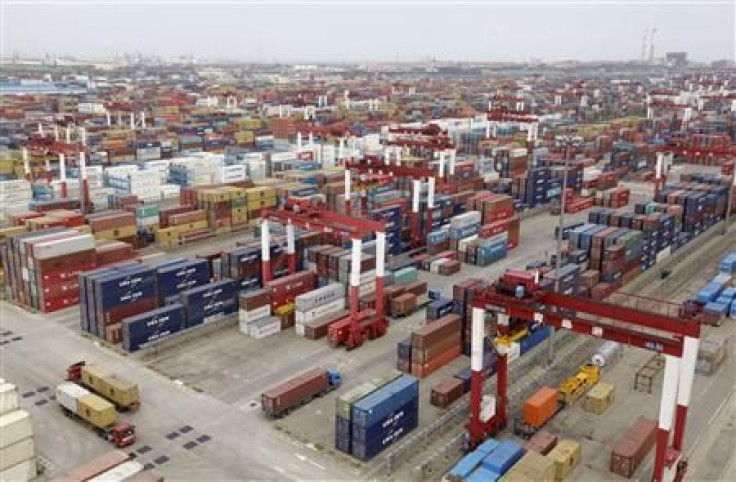China Q3 GDP Preview: Why Slowdown In Growth Will Likely Continue

Don’t expect China’s September data bounce to change the script.
While a better-than-expected reading on China’s exports over the weekend broke a run of bad economic reports, the world's second-largest economy is still widely expected to mark its seventh consecutive quarterly slowdown in growth in the July-September period.
Analysts look for official data due on Thursday to confirm that gross domestic product growth slipped to 7.4 percent in the third quarter, undershooting the 7.5 percent rate mandated by Beijing for 2012 and leaving the economy on track for its most sluggish year of expansion since 1999. Underlining the weakness, the World Bank last week downgraded its forecast for China’s full-year growth to 7.7 percent from its May outlook of 8.2 percent.
At a time when the U.S. is growing at close to 1 percent annually, and Japan and Europe are barely growing at all, China’s mid-7 percent growth still seems quite remarkable by global standards. Yet, it is a far cry from China’s experience.
As the third-quarter earnings season heads into full swing, investors will likely get fresh confirmation on how China’s slowdown is threatening to sap U.S. corporate profits. Aluminum giant Alcoa Inc. (NYSE: AA) has already lowered its forecast of aluminum-demand growth for the year, citing a slowdown in China.
The concern is that all drivers of GDP growth appear to be faltering.
Exports
Net exports used to contribute about 2 or 3 percentage points to China’s economic growth rate. But China is likely to grapple with weaker external demand during the rest of 2012 due to the slowing global economy. Exports, which generated 31 percent of GDP in 2011, have become a drag instead.
After plummeting to a six-month low in July, China’s export growth picked up slightly in August and September. Although September exports exceeded forecasts, up almost 10 percent from a year earlier, analysts say the trade outlook remains grim.
Moreover, seasonal factors may have influenced the latest export numbers as manufacturers rushed to get Christmas shipments out to retailers in the West before the “golden-week” holiday that ran for the week at the beginning of October. Another factor was that last year’s September numbers were low because the Chinese mid-autumn festival landed in September 2011. This year it was in October.
Investment
Fixed-asset investment in China grew from 34 percent of GDP in 2000 to over 44 percent in 2011 -- an average annual growth rate of 12.7 percent, relative to a 10.4 percent rate of growth in GDP during this period.
Although there is still plenty of capital spending, there is now a huge base of physical capital, and new investment is becoming less efficient: A given increase in capital leads to a smaller increase in GDP.
Consumption
While retail sales have been resilient this year, the economy’s shift to a consumption-led model is occurring only gradually.
Household consumption, which accounts for 70 percent of the U.S. GDP, contributes only about 35 percent of Chinese GDP.
Trade data released Saturday showed no sign of improvement in domestic demand, as Chinese imports revived only slightly in September from the previous month's contraction.
Lack Of Easing
Inflation has fallen steadily from a three-year peak of 6.5 percent in July 2011, running at or below 3 percent since May -- well below the government's 4 percent target.
The muted inflation should provide ample room for continuous policy easing without fear of igniting big price increases. But the central government has been very reluctant to do more to arrest the slowdown -- unlike in late 2008, when the central bank loosened policy aggressively and Beijing unleashed a major stimulus to power the economy past the global financial crisis.
The People’s Bank of China last cut interest rates in early July, and it has not lowered lenders’ required reserves since May.
Analysts expect no major new initiatives until a once-a-decade handover of power to younger Communist Party leaders begins at a meeting in November.
"We do not expect the government to come up with any major new stimulus, either during the leadership transition or after, unless the economy takes a turn for the much worse," UBS economist Tao Wang said in a report.
Another explanation is that after their huge stimulus in 2008 ignited inflation and a wasteful building boom, Chinese leaders have come to the conclusion that slower growth is desirable for the country. They are trying to shift the economy toward consumption-driven growth and away from being an economy fueled by investment.
The apparent strength of tourism and spending during October’s “golden-week” holiday has revived hopes that China could experience a consumer-led rebound. But there is little convincing evidence that spending growth is doing anything better than standing still.
“In the near term though, talk of a consumer-led rebound remains unrealistic,” said Mark Williams and Qinwei Wang of Capital Economics in a report.
© Copyright IBTimes 2024. All rights reserved.












